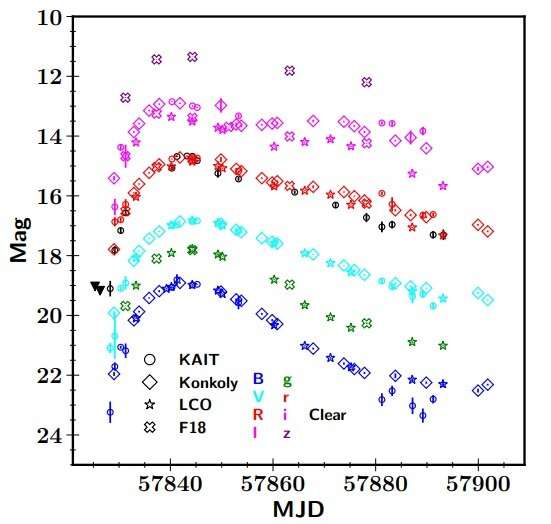Light curve of SN 2017cfd from KAIT, LCO, Konkoly, and the Foundation Supernova Survey observations (labeled as F18); colors and symbols are coded for different filters and sources. The two black solid triangles mark the nondetections from KAIT Clear observations one and two days before discovery. Credit: Han et al., 2019.
An international team of astronomers has conducted follow-up photometric and spectroscopic observations of SN 2017cfd—a Type Ia supernova that was discovered some 38 hours after the fitted first-light time. Results of the new study, presented in a paper published November 18 on arXiv.org, reveal more details about the properties of this source.
Type Ia supernovae are found in binary systems in which one of the stars is a white dwarf. Stellar explosions of this type are important for the scientific community as they offer essential clues into evolution of stars and galaxies. SN 2017cfd is a Type Ia supernova that was discovered very young, about 1.6 days after the fitted first-light time. The explosion was detected on March 16, 2017 with the 0.76-meter Katzman Automatic Imaging Telescope (KAIT), at a redshift of approximately 0.012.
Almost immediately, a group of astronomers led by Xuhui Han of Chinese Academy of Sciences commenced a photometric and spectroscopic follow-up monitoring campaign of this source using KAIT and other ground-based telescopes. Follow-up observations of such early-discovery Type Ia supernovae could be crucial for determining the physical properties of these explosions and for unveiling their progenitor systems.
"In this paper, we have presented optical photometric and spectroscopic observations of SN 2017cfd, which was discovered very young, with the first detection merely 1.6 ± 0.7 d after the FFLT [fitted first-light time]," the astronomers wrote in the paper.
Results of the observations indicate that SN 2017cfd is a normal Type Ia supernova with a peak luminosity of -19.2 mag. It took it approximately 16.8 days after the fitted first-light time to reach B-band maximum, what is typical for Type Ia supernovae.
Moreover, the study found that that the spectra of SN 2017cfd exhibit absorption features from ions typically seen in Type Ia supernovae. It was noted that the absorption line of silicon (Si II λ6355) velocity of SN 2017cfd was measured to about 11,200 km/s. This value is also typical for Type Ia supernovae.
Based on the early-time photometric data, the astronomers ruled out the assumption that the companion star of SN 2017cfd is a red giant. The results point out to an object with a radius not greater than 2.5 solar radii.
The paper emphasizes the importance of further studies of SN 2017cfd, taking into account its early discovery. There are currently fewer than 20 Type Ia supernovae with color data from the first three days, and fewer than a dozen objects of this class with color data in the first two days.
"Thanks to the early discovery and photometric follow-up, SN 2017cfd remains valuable at this stage for building up a bigger sample for studying SNe Ia at very early times. A significantly larger sample is being obtained with available new facilities (e.g., the Zwicky Transient Facility, ZTF), and with future new telescopes there will be many such discoveries (e.g., the Large Synoptic Survey Telescope)," the authors of the paper concluded.
More information: SN 2017cfd: A Normal Type Ia Supernova Discovered Very Young, arXiv:1911.07734 [astro-ph.SR] arxiv.org/abs/1911.07734
© 2019 Science X Network
























